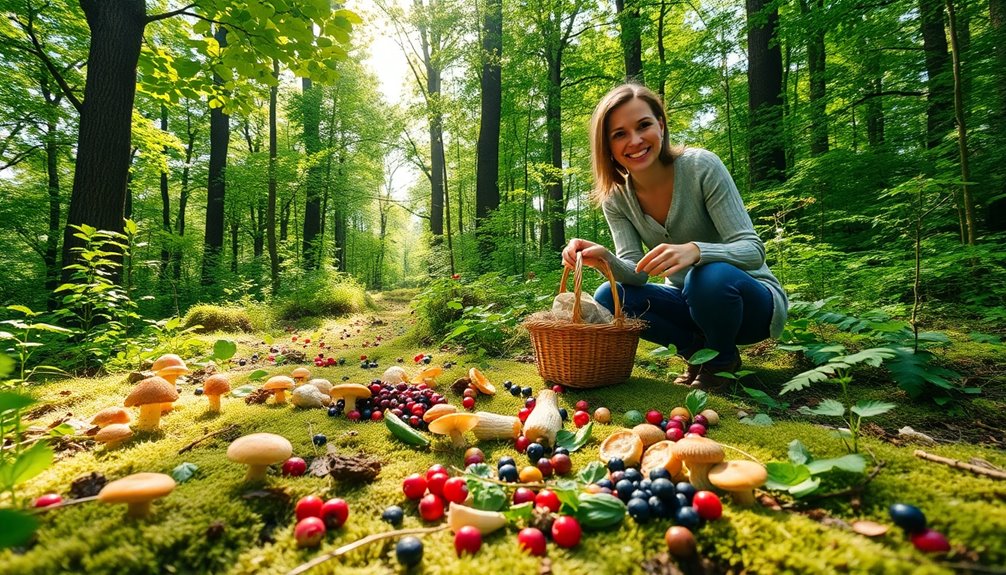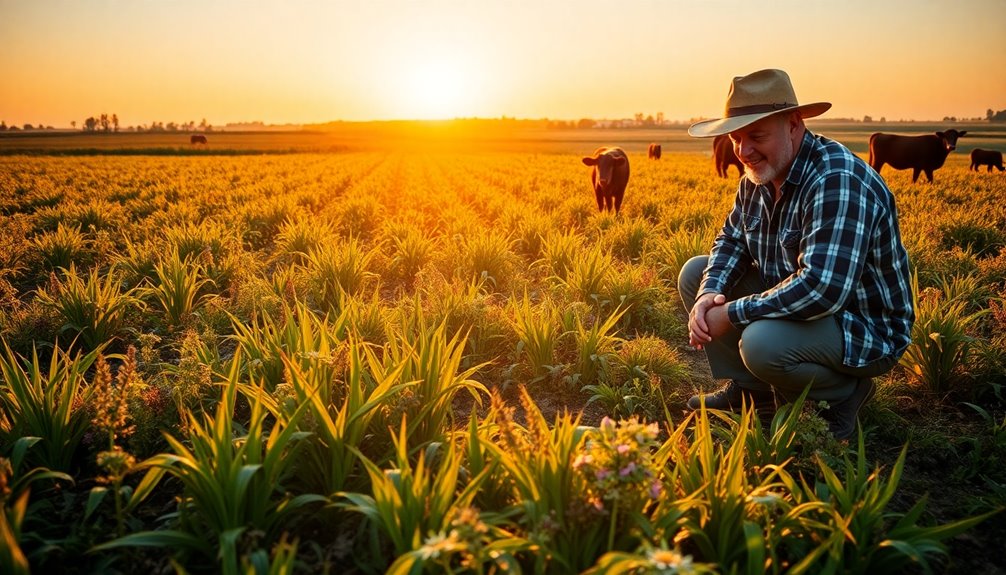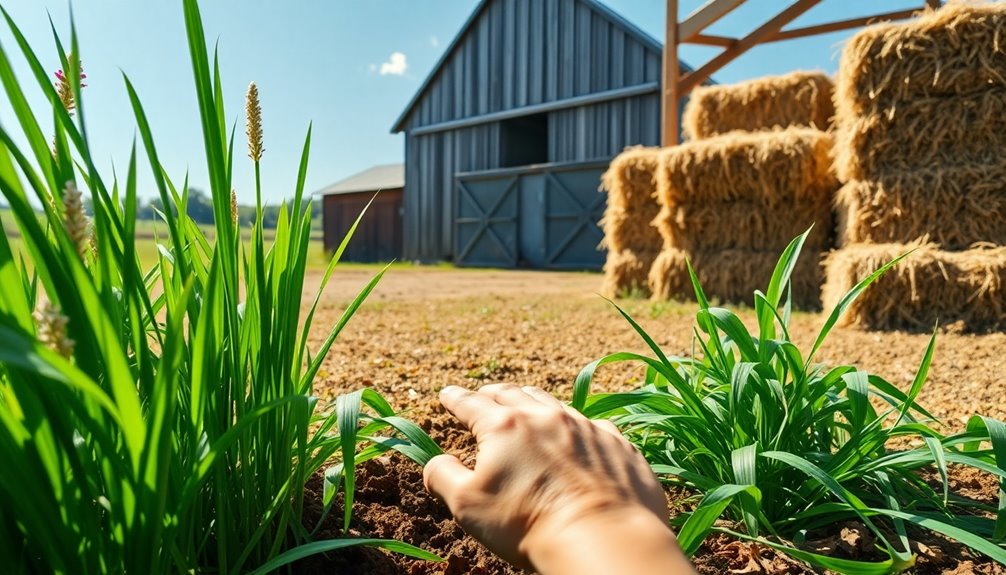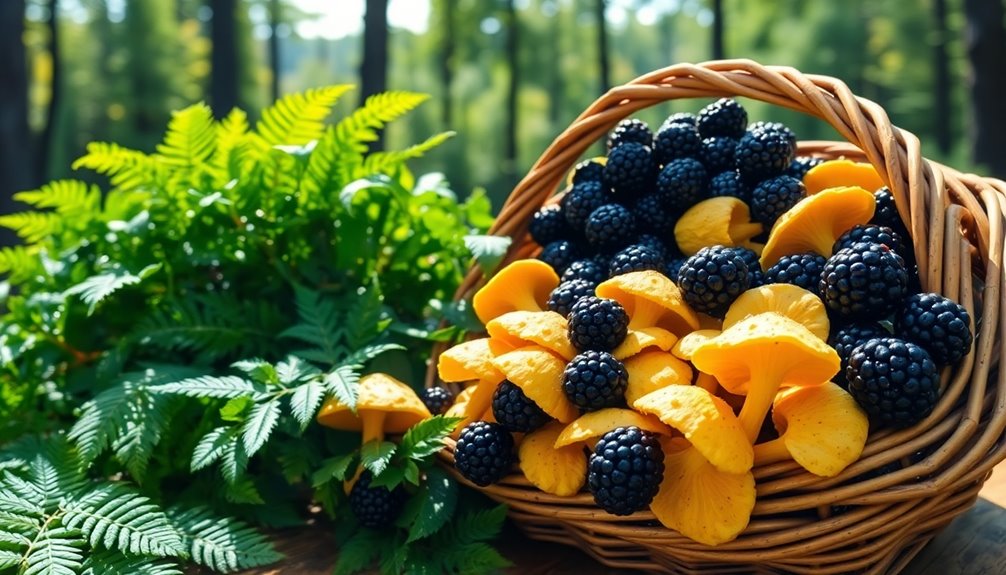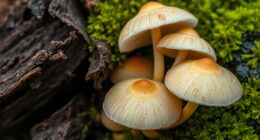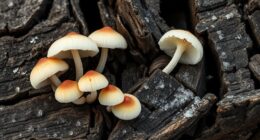Foraging is a fantastic way to enhance your health, save money, and support the environment. You'll discover nutrient-dense wild foods that often surpass store-bought produce in vitamins and antioxidants, promoting overall wellness. Plus, it can reduce your grocery bills by up to 30%, offering free, fresh options right from nature. Foraging also boosts community spirits and encourages sustainable practices, helping you connect with your local ecosystem. By harvesting responsibly, you can enjoy a meal that not only tastes great but also contributes to environmental stewardship. Keep exploring to uncover even more benefits of incorporating foraged foods into your life!
Key Takeaways
- Foraging provides nutrient-dense wild foods, often richer in vitamins and antioxidants than store-bought produce, enhancing overall health and wellness.
- It can reduce grocery expenses by up to 30%, offering free access to abundant wild plants and minimizing transportation costs.
- Sustainable foraging practices help protect local ecosystems, reduce carbon footprints, and promote biodiversity by responsibly harvesting and managing wild plant populations.
- Community foraging fosters connections among individuals, enhancing local knowledge sharing and promoting environmental stewardship through educational opportunities.
- Foraged ingredients inspire culinary creativity, transforming everyday meals into unique experiences while encouraging exploration of seasonal flavors and techniques.
Overview of Foraging Benefits

When you explore the world of foraging, you access a treasure trove of benefits that go beyond just finding food. One of the standout perks is that wild foods often pack a nutritional punch. Studies show they can contain higher levels of vitamins and antioxidants compared to commercially grown produce. By choosing wild options, you're not just eating healthier; you're also saving money. Estimates suggest that foraging for wild vegetables can cut your grocery bills by up to 30%, making it a wallet-friendly choice.
Moreover, foraging promotes a deeper connection to local ecosystems. When you engage in responsible harvesting practices, you help enhance plant populations, fostering biodiversity. In addition, understanding tree relationships can significantly improve your foraging success by guiding you to the best wild edibles. Furthermore, incorporating non-perishable items into your foraging strategy can provide a balanced approach to food sustainability.
Plus, the physical activity that comes with foraging is a fantastic way to boost your overall health and well-being. It turns nature into your playground, similar to a scavenger hunt, which keeps the experience fun and engaging.
Lastly, by relying less on commercial agriculture and minimizing food transport, foraging supports environmental stewardship. This reduces your carbon footprint while enjoying the great outdoors.
In short, foraging is a win-win for your health, wallet, and the planet.
Foraging vs. Gardening
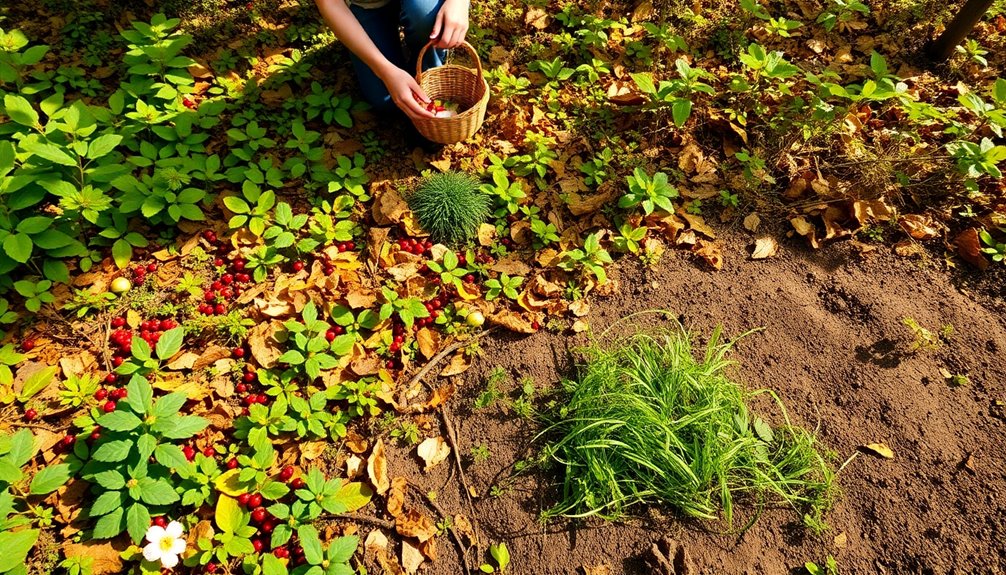
Foraging offers a distinct advantage over gardening, especially regarding time and resource efficiency. You can step outside and gather a variety of edible plants without the lengthy processes of soil preparation, planting, and maintenance that gardening demands. With foraging, you get immediate access to fresh, nutritious ingredients, eliminating the waiting period associated with growing your own food. Additionally, many foraged foods, such as chia seeds, offer significant nutritional benefits, enhancing your overall diet. Chia seeds, for instance, were historically valued by ancient civilizations for their high nutritional value, which contributed to their endurance and energy levels. This is due to their high omega-3 content, which supports heart health and overall well-being, while their high fiber content can also promote satiety and aid in weight management.
Moreover, foraging doesn't require land ownership or designated space. You can explore various environments, from parks to forests, making it accessible to those who may not have a garden at home. Unlike cultivated gardens that might rely on chemical fertilizers or pesticides, wild food typically grows abundantly and naturally. This means you can enjoy healthier options straight from nature.
Engaging in foraging also encourages you to connect with local ecosystems and biodiversity. You'll discover a wider range of edible species than what you might find in a typical home garden. This exploration not only enriches your diet but also fosters a deeper appreciation for the environment around you. Additionally, foraging can enhance your understanding of educational toys, as you learn about the plants and their uses, which can lead to creative play and exploration for children.
In many ways, foraging allows you to embrace nature's bounty while saving time and resources.
Cost-Effectiveness of Foraging
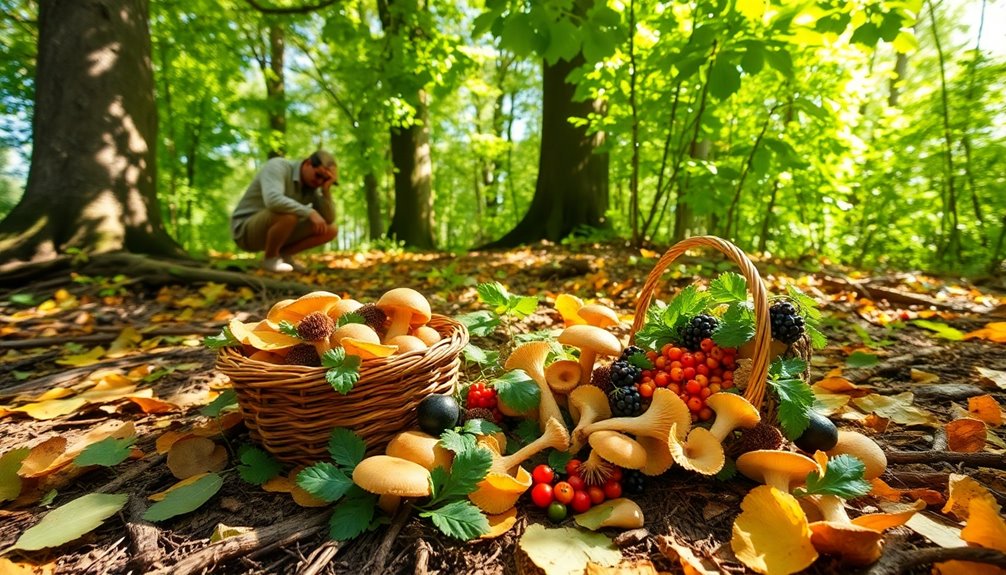
When you choose to forage, you make a minimal financial investment while tapping into free local resources.
You'll find that wild foods are often abundant in your area, offering a cost-effective way to access fresh produce.
Minimal Financial Investment
Exploring the great outdoors can lead to significant savings on your grocery bills, with some estimates suggesting you could cut costs by up to 30% by harvesting wild vegetables and fruits. Foraging requires minimal financial investment, as most wild plants are free and abundant in nature. This means you can fill your basket without draining your wallet.
Here are three cost-effective benefits of foraging:
- Free Food: Wild vegetables, fruits, and herbs are often found in urban parks and green spaces, providing a no-cost alternative to store-bought produce.
- Fresh and Nutritious: Foraged items aren't only free but also often fresher than what you find at the grocery store, giving you access to seasonal ingredients that are packed with nutrients. Additionally, many foraged foods reflect traditional healing practices that have been valued by Indigenous cultures.
- Mindful Consumption: By focusing on what's in season, you reduce food waste and avoid the high costs associated with out-of-season produce.
Additionally, foraging can support sustainable harvesting practices, promoting ecological balance and biodiversity.
Incorporating urban foraging into your routine can transform the way you look at food, making it both wallet-friendly and rewarding.
Why not step outside and see what nature has to offer?
Free Local Resources
Accessing free local resources can enhance your foraging experience and make it even more cost-effective. By utilizing these resources, you can greatly reduce your grocery bills, potentially saving up to 30% on food costs. Many public libraries offer valuable guides on identifying edible plants and mushrooms, all at no cost to you. In regions like Minnesota, foragers can find a wealth of seasonal edibles that are easy to identify and harvest, especially when using resources that encourage hands-on learning and exploration. Additionally, using natural hair styling products can provide insights into the benefits of organic ingredients, paralleling the value of foraging for natural food sources. Exploring unique planter designs can also inspire you to cultivate your foraged finds in a visually appealing way.
Online communities and local foraging groups also serve as excellent support systems, allowing you to share tips and experiences without any financial investment. This not only fosters a sense of community but also helps combat food waste by promoting the use of abundant wild food.
Here's a quick overview of some free local resources you can tap into:
| Resource Type | Examples | Benefits |
|---|---|---|
| Libraries | Foraging books and guides | Knowledge on edible plants |
| Online Communities | Social media groups | Shared experiences and tips |
| Local Foraging Groups | Workshops and meetups | Hands-on learning and support |
Engaging with these resources not only enriches your foraging skills but also contributes to food security within your community. Additionally, utilizing budgeting techniques can help you make the most of your foraged finds. So, why not explore these free local resources?
Abundant Wild Food Access
Foraging offers an incredible opportunity to tap into abundant wild food sources, making it a smart choice for those looking to save money on groceries. By harvesting wild plants, you can greatly reduce your grocery bills—saving up to 30% on food costs!
Here are three ways foraging enhances your food system without breaking the bank:
- Free Nutrition: Wild foods like dandelion greens and wild garlic are both abundant and free, providing a nutritious alternative to store-bought produce. Additionally, foraging allows you to discover native plant species that can enhance the nutritional diversity of your diet. Many wild plants also contain high-quality nutrients that contribute to overall health, such as vitamins A, C, and K which are essential for various bodily functions.
- No Transportation Costs: Foraging eliminates the need to travel to the grocery store, cutting down on transportation expenses and making meal planning more cost-effective.
- Community Resources: You can access wild edibles in public green spaces and urban parks, meaning you don't need to invest in land or gardening supplies.
With minimal equipment needed, you can engage in this sustainable practice without incurring substantial financial expenses. Additionally, incorporating foraged foods into your diet promotes organic gardening practices, enhancing biodiversity and health in your eating habits.
Building Community Through Foraging
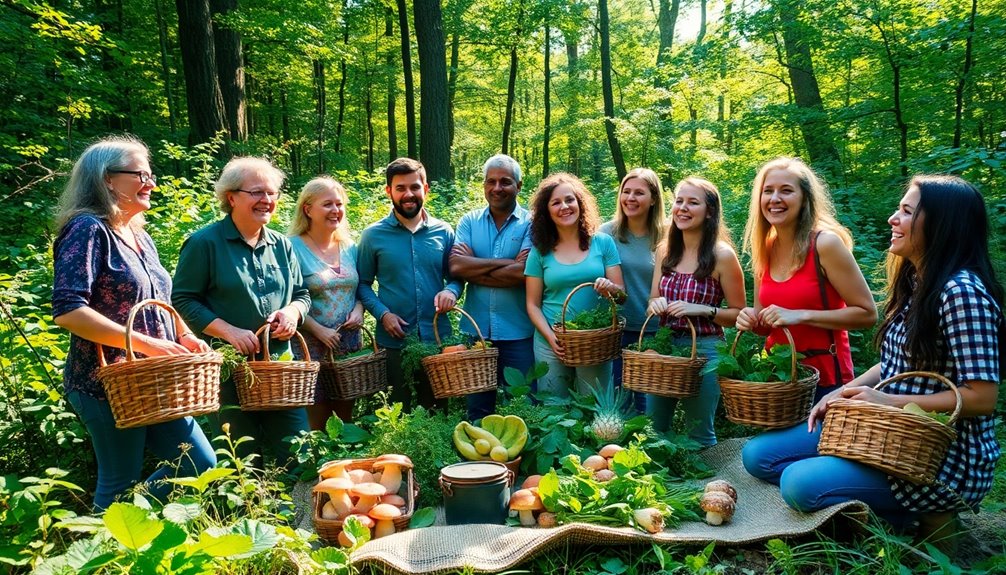
In recent years, more people have discovered the joys of foraging as a way to connect with nature and each other. Community foraging activities foster bonding among friends and family, creating shared experiences that enhance teamwork and communication while exploring local edible species.
When you participate in community foraging groups, you'll find opportunities to connect with like-minded individuals who share local knowledge. These gatherings often spark discussions about foraging finds and the local ecosystems around you.
Guided foraging experiences can further deepen your community engagement, allowing you to learn from experts and meet other foragers in your area. By participating in these events, you're not only gaining new skills but also helping to build a supportive network that encourages sustainable practices and environmental stewardship.
Local foraging events serve as fantastic community-building activities, bringing people together to explore nature and appreciate the abundance of wild food available in your environment.
Environmental Impact of Foraging
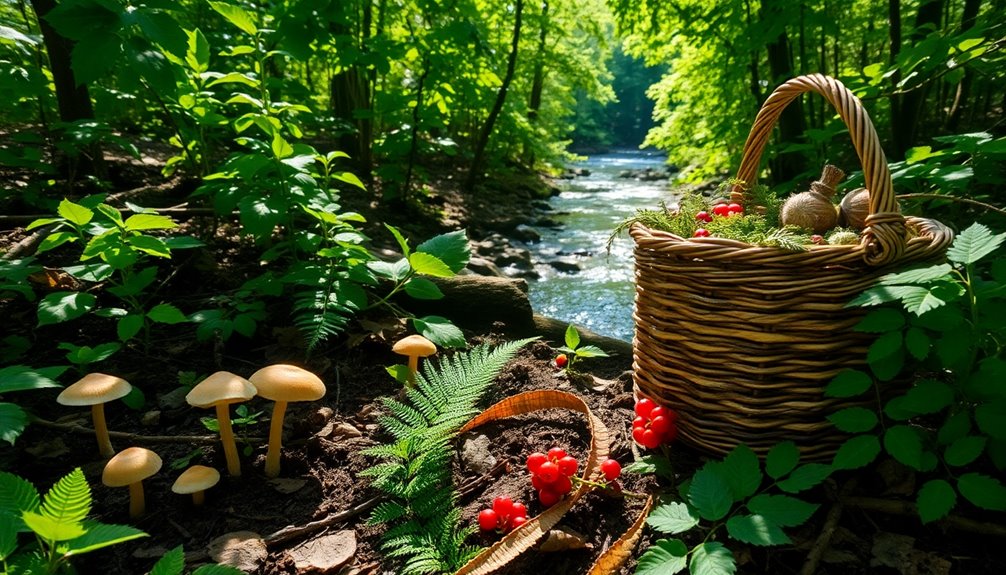
Connecting with nature through foraging not only strengthens community bonds but also fosters a deeper understanding of local ecosystems. By engaging in foraging, you can make a positive environmental impact while enjoying sustainable food options.
Here are three key benefits:
- Biodiversity Awareness: Foraging increases your awareness of native plant species, promoting appreciation for the biodiversity around you. This understanding encourages efforts to protect local flora.
- Ecological Balance: Practicing sustainable foraging means you harvest responsibly, allowing plants to regenerate and preventing overexploitation of wild food sources. This approach helps maintain ecological balance, ensuring that ecosystems thrive.
- Invasive Species Control: Foraging can also help combat invasive species. By consuming these plants, you contribute to controlling their populations, which mitigates their negative effects on native ecosystems.
Ultimately, by choosing to forage, you reduce your reliance on commercial agriculture, lowering the carbon footprint tied to food transportation and industrial farming practices.
Engaging with your local environment not only supports your community but also strengthens your role as an environmental steward.
Nutritional Advantages of Wild Foods
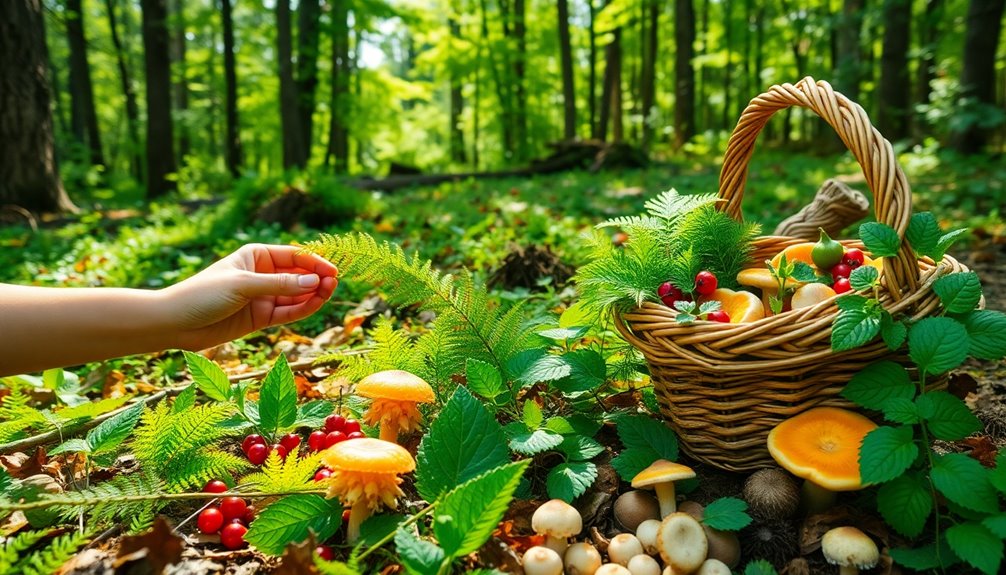
Have you ever wondered how wild foods stack up against the produce you find in stores? You might be surprised to learn that foraged plants often pack a nutritional punch. Studies show that these wild foods can be richer in vitamins, minerals, and antioxidants essential for your overall health.
For instance, dock leaf can deliver up to 80% of your daily recommended intake of vitamins A and C in just 100 grams, highlighting the nutrient density of wild edibles.
Many foraged greens, like dandelion, rival superfoods such as kale, offering impressive health benefits, including anti-inflammatory properties and high vitamin content. By incorporating these wild foods into your diet, you can enhance your immunity and overall wellness, thanks to unique compounds not typically found in cultivated varieties.
Foraging also encourages you to diversify your food choices. This varied diet supports different aspects of health, from digestion to cardiovascular well-being.
Sustainable Foraging Practices
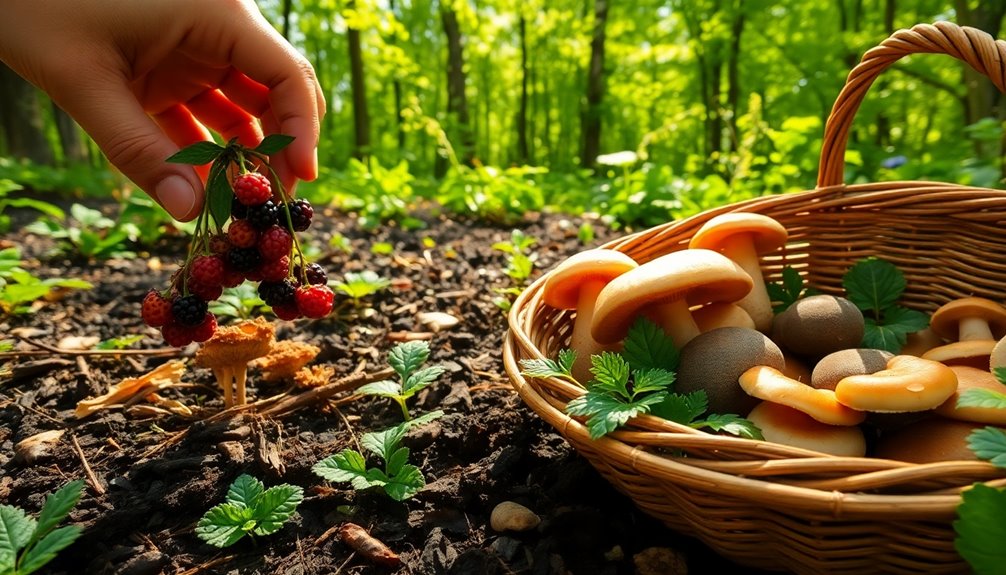
When you forage, practicing responsible harvesting techniques is essential to maintaining healthy ecosystems.
By following seasonal foraging guidelines, you can guarantee that you're gathering plants at their peak while allowing them to thrive for future generations.
This approach not only benefits the environment but also enhances your foraging experience.
Responsible Harvesting Techniques
Responsible harvesting techniques are essential for maintaining the balance of our ecosystems while enjoying the bounty of nature. By following these practices, you can guarantee that your foraging efforts benefit both you and the environment.
- Limit Your Take: Only gather up to 10% of any edible plant species you find. This allows populations to regenerate and thrive, guaranteeing future foraging opportunities. Additionally, understanding the environmental factors that impact plant growth can help you make informed decisions while foraging. Over time, foraging range can also vary depending on the health of plant populations in an area. Implementing proper watering techniques for any cultivated plants can further ensure their longevity and sustainability. It's important to recognize that high vibrational energy can enhance your connection with nature during foraging.
- Identify Accurately: Always make certain you can identify plants accurately before harvesting. Some edible species have poisonous look-alikes, so consider using local guides or foraging apps for assistance.
- Choose Abundant Areas: Forage in locations where wild food is plentiful, avoiding sensitive environments to prevent overharvesting. Leaving the mycelium intact when picking mushrooms promotes their growth and preserves the species. Engaging with local foraging groups or attending workshops can also enhance your knowledge of responsible harvesting techniques. Additionally, being informed about essential survival skills can further enhance your foraging experience and safety.
By adopting these sustainable practices, you not only support the environment but also foster a community centered around foraging and appreciation for nature's gifts.
Happy foraging!
Seasonal Foraging Guidelines
Understanding seasonal foraging guidelines can greatly enhance your foraging experience while promoting sustainability. By foraging at the right times, you'll maximize the availability of specific wild foods. For instance, wild garlic thrives in spring, offering a fresh, nutrient-dense option that you can enjoy in various dishes.
Similarly, mushrooms become abundant in the fall, making it an ideal time to gather these flavorful fungi.
To practice responsible foraging, only harvest what you need and leave enough plants to continue thriving. This approach guarantees sustainability for future seasons and minimizes ecological disruption.
Timing is vital; foraging during peak growth periods not only enhances the quality of your harvest but also allows plants to regenerate effectively.
Understanding local ecosystems and plant life cycles is key to engaging in sustainable practices. By respecting seasonal growth patterns and avoiding overharvesting, you contribute to biodiversity.
This encourages the consumption of underutilized plants, which supports local ecosystems and promotes diverse flora.
Culinary Uses of Foraged Ingredients
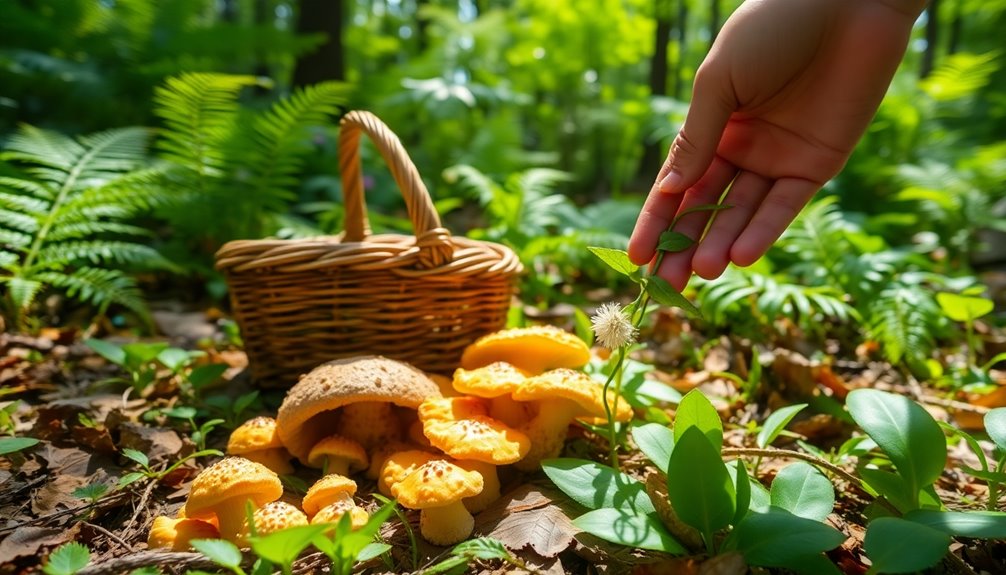
Foraging opens up a world of culinary possibilities, allowing you to transform everyday meals into extraordinary experiences. By exploring the natural world, you can discover unique flavors that elevate your cooking and enhance your dishes.
Here are three ways to use foraged ingredients:
- Wild Garlic: This robust herb not only boosts your dishes but also packs a punch with heart-healthy compounds like allicin. Use it in pesto, soups, or as a seasoning for roasted vegetables.
- Edible Flowers: Dandelions and other blooms add visual flair and essential vitamins A, C, and K. Toss them into salads or steep them in hot water for a rejuvenating herbal tea.
- Wild Berries: These gems are often sweeter and more flavorful than their cultivated counterparts. Use them in desserts, jams, or smoothies for a delicious, nutritious treat.
Incorporating foraged ingredients encourages creativity and seasonal cooking, allowing you to explore flavors like foraged mushrooms in risottos or pasta.
With each meal, you'll not only enjoy delicious food but also connect with the wild, enriching your culinary adventures.
Educational Opportunities in Foraging
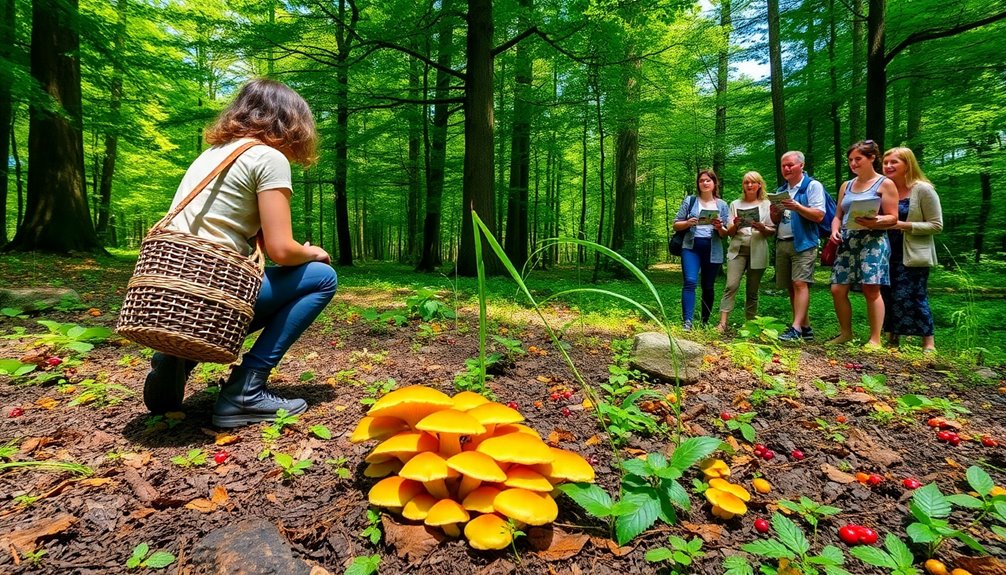
Exploring the world of wild edibles can be an eye-opening journey that deepens your appreciation for nature. Foraging offers numerous educational opportunities that enhance your understanding of local ecosystems and plant identification. As you learn to identify safe, edible plants and mushrooms, you'll gain confidence and foster a stronger connection to the environment.
Community foraging groups and workshops provide hands-on experiences where you can engage with others who share your interests. These gatherings help cultivate your knowledge and skills, ensuring you make informed choices while foraging. Reference books and online resources also serve as valuable tools, offering extensive information on foraging techniques, safety practices, and the nutritional benefits of wild foods.
Guided foraging experiences, like those offered by organizations such as No Taste Like Home, teach sustainable harvesting and highlight the ecological impact of foraging.
Additionally, involving your family in foraging activities can be a wonderful educational experience, instilling in children the importance of nutrition, biodiversity, and respecting natural resources. By embracing these educational opportunities, you'll not only enjoy foraging more but also contribute positively to the environment.
Frequently Asked Questions
Why Is Foraging Good for the Environment?
Foraging's great for the environment because it helps promote biodiversity.
When you gather wild foods, you're supporting local ecosystems that thrive without chemical fertilizers or pesticides.
Plus, you can manage invasive species like garlic mustard by eating them, which reduces their spread naturally.
By foraging, you also cut down on the carbon footprint linked to commercial agriculture.
Ultimately, it fosters a deeper connection to your local flora and encourages responsible environmental stewardship.
What Are the Health Benefits of Foraging?
Imagine wandering through a sun-dappled forest, where each step could lead to a nutrient-packed treasure.
When you forage, you're not just gathering food; you're boosting your health. Wild foods often outshine cultivated crops in vitamins and minerals, enhancing your immune system.
Plus, the physical activity keeps you fit, and the connection with nature calms your mind.
Why Was Foraging Important?
Foraging was essential for survival, providing you with fundamental nutrition long before agriculture emerged.
By gathering wild foods, you tapped into diverse diets that offered critical nutrients often missing from cultivated crops. This practice not only kept you healthy but also connected you deeply to your environment.
You learned to recognize seasonal changes and developed a respect for nature, fostering a sense of stewardship for the land that supported your existence.
How Does Forage Affect the Environment?
When you forage, you're not just picking plants—you're planting seeds of environmental awareness.
Foraging affects the environment positively by promoting biodiversity and maintaining ecological balance. By responsibly harvesting edible plants, you help control invasive species and support native flora.
This sustainable practice reduces reliance on commercial agriculture, which often harms ecosystems. As you connect with nature, you'll feel motivated to protect it, fostering a deeper appreciation for the world around you.
Conclusion
In a world where grocery prices keep rising, foraging offers a revitalizing alternative. Imagine swapping expensive, store-bought produce for vibrant wild greens and hearty mushrooms, all while connecting with nature and your community. It's not just about saving money; it's about embracing a lifestyle that nourishes your body and the environment. So, whether you're an experienced forager or just curious, step outside and discover the wealth of flavors waiting in the wild—it's more rewarding than you think!

